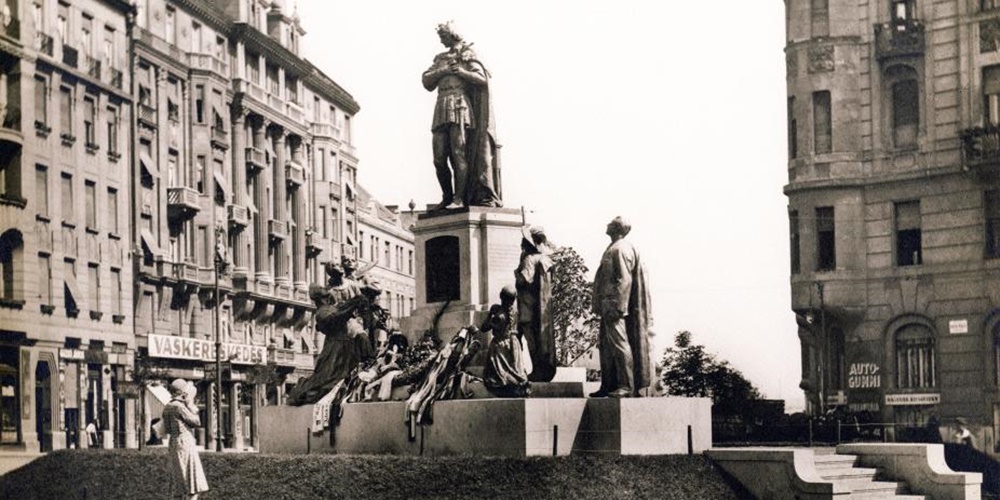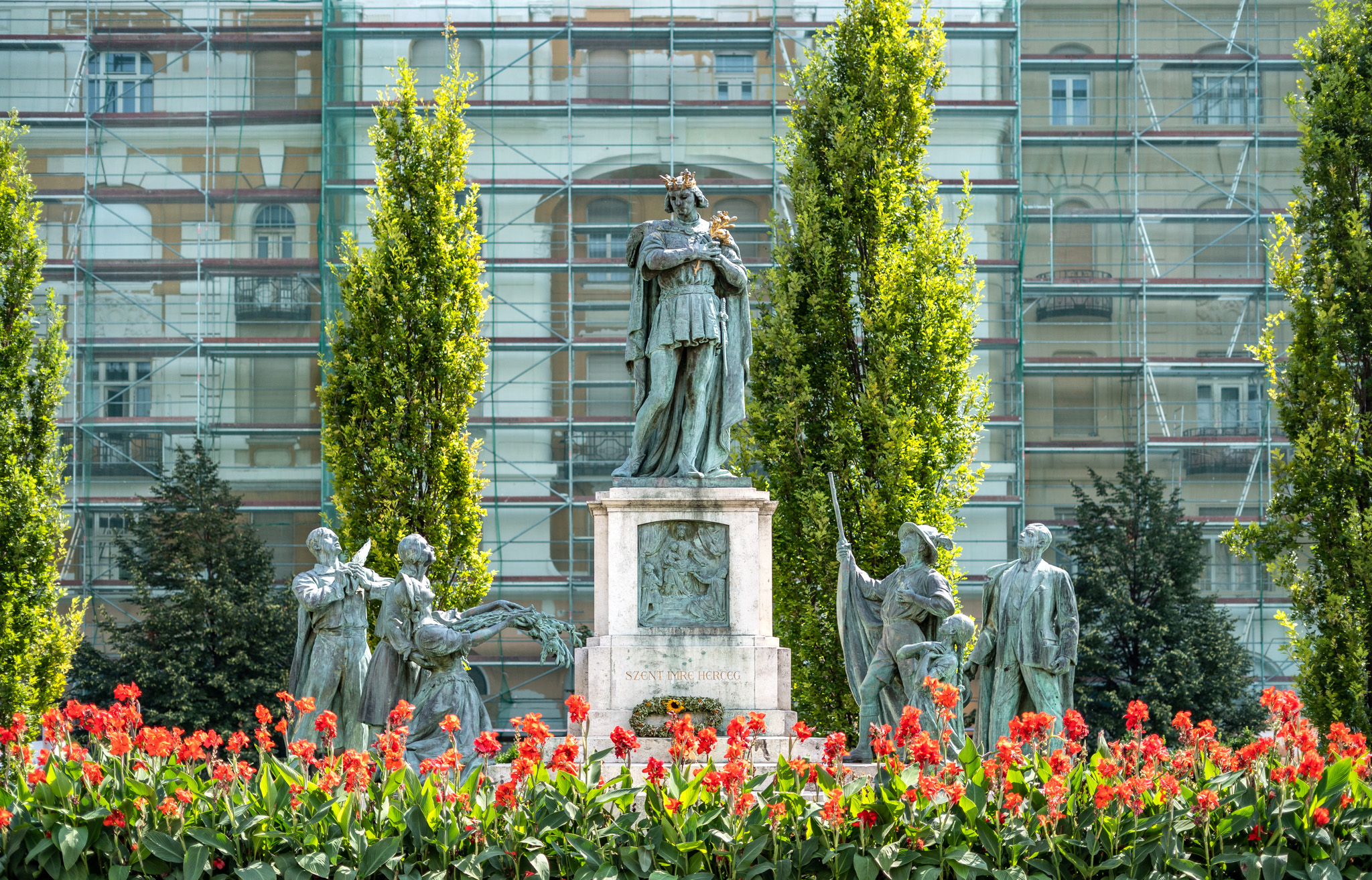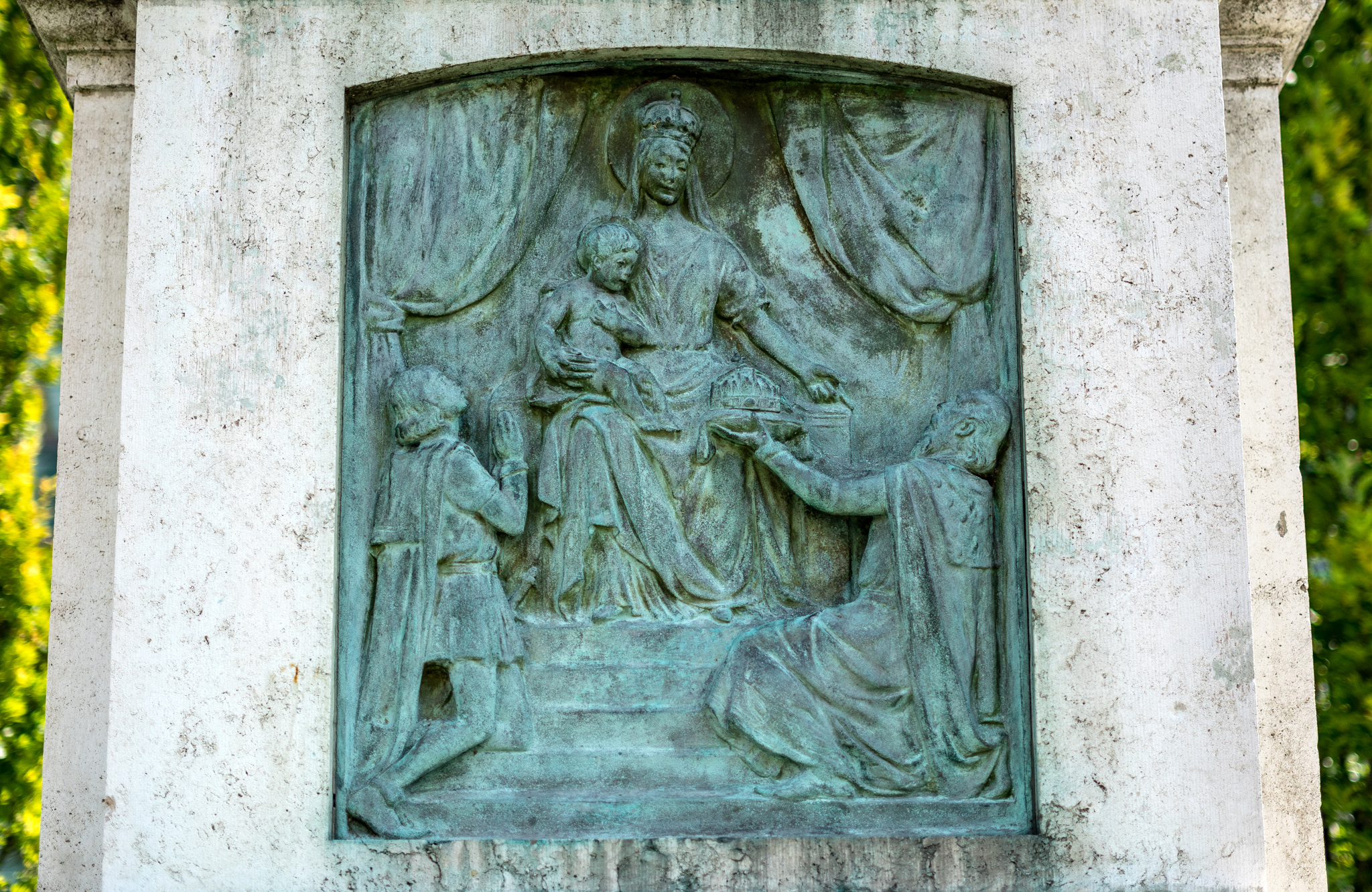Saint Emeric, the son of Saint Stephen, the founding king of Hungary, died young in 1031 while hunting. Little is known about his real life, but later legends painted the image of a virgin Christian prince. This made Prince Emeric and his never-to-be reign one of the great lost opportunities of Hungarian history in the eyes of later generations.

The statue of Prince Saint Emeric stands on Zsigmond Móricz Circus in the 11th District (Photo: Balázs Both/pestbuda.hu)
Especially in a period when the emphasis on the greatness of the past came to the fore. Although the cult of the young prince was always present in the Catholic tradition, it culminated in the St. Emeric Memorial Year between 18 May 1930 and 31 May 1931. The ecclesiastical year of remembrance was organised on the 900th anniversary of the prince’s death. During the year, the Hungarian state and the Catholic Church organised several huge ceremonies.
The statue, however, was not ordered by the state or the capital but by a private individual, namely Archduchess Isabella von Croÿ-Dülmen, who lived in Hungary with her husband, the retired Commander-in-Chief of the Imperial and Royal Army.
The monumental group of sculptures was unveiled on Sunday, 17 August 1930, with incredible splendour. Contemporary reports claimed that such pomp had last been seen during the coronation of Charles IV.

The group of sculptures in 1937 (Source: Fortepan, Új Nemzedék)
The statue was placed near the si7te of the martyrdom of the young prince's educator, Bishop Gerard, in a dynamically developing part of Budapest, the newly independent 11th District.

The composition in August 2020 (Photo: Balázs Both/pestbuda.hu)
In the 11th century, the southern side of Gellért Hill was a largely undeveloped, deserted area with only one clay mine. However, with the opening of the Ferenc József Bridge (today Szabadság Bridge), this area was built up incredibly quickly, multi-storey residential houses were built along Átlós Road, the Technical University moved to the area, and the Circus was built as the centre of the new area.
Átlós Road was first renamed Fehérvári Road. Then together with the square, it took the name of the governor, Miklós Horthy. In addition, one of the streets starting from the square, today's Villányi Road, was called Szent Imre Herceg Road ('Prinec Saint Emeric') and from 1929, the Szent Imre Grammer School also operated on the street. This is why the circus was chosen as the site of the statue.

Saint Emeric as a symbol of innocent youth (Photo: Balázs Both/pestbuda.hu)
The group of sculptures, the main and minor figures, were made by Zsigmond Kisfaludi Strobl. The 19 August 1930 issue of the Nemzeti Újság described the work as follows:
“St. Emeric is clad in decorated clothes. He has a crown on his head similar to the crown of Saint Margaret. He turns his face of the holy prince to the youth around him. He presses a lily to his heart with both hands, symbolizing the love of innocence. The figure to the right drops to his knees in Hungarian clothes, and offers the prince lilies with both hands, next to him a schoolgirl brings her innocent heart. On the edge of the monument stands a soldier in awe, a cap in his hands. The main figure of the left group is the scout, standing with his left hand on his heart, in front of him a small peasant girl looks up in amazement, behind him stands a talented student. The relief on the front of the foundation of the statue depicts Saint Stephen as he offers the Holy Crown to the Blessed Virgin; Saint Emeric kneels in front of him. On the back of the pedestal of the statue stands the coat of arms of Archduchess Izabella and a bronze wreath of wildflowers, the latter donated by Archduke Albrecht on behalf of Hungarian youths.”
The completed work was inaugurated by Primate Justinián Serédion on 17 August 1930, but a speech was given by Governor Miklós Horthy and several other secular and ecclesiastical dignitaries.

The statue was funded by Archduchess Isabella von Croÿ-Dülmen, as can be read on the pedestal of the statue (Photo: Balázs Both/pestbuda.hu)
The 11th District, which also became administratively independent in 1930, took the name Szentimreváros ('Saint Emeric City)
In light of the above, it is obvious how distant the statue was from the communist regime, which grabbed power between 1945 and 1949, and which was based in part on the complete ideological rejection of the system that existed in the inter-war years. The square was renamed Móricz Zsigmond Circus, Szent Imre Herceg Road became Villányi Road, and the district also lost the name Szentimreváros. (From the outset, socialism did not like the names district used.)

The side figures of the statue symbolized the youth. A scout stands in the composition, which is the only scout statue that was not removed from the public spaces of Budapest after 1945 (Photo: Balázs Both/pestbuda.hu)
The statue, which fortunately survived the war, remained in place. Yet, there were plans to remove it. The first plans were floated in the 1950s. In January 1956, the Executive Committee of the Budapest Soviet City Council discussed the placement of the statue of Zsigmond Móricz. At the meeting, the idea to remove Saint Emeric's statue before placing the writer's was mentioned.

The statue in 1956 (Photo: Fortepan/No.: 40032)
However, the statue remained. In the 1956 revolution, during the fighting, it was damaged but not destroyed. However, the idea that the statue should be removed was not forgotten. In the 2 October 1957 issue of Magyarország, in a reader's letter, stated:
“Prince Emeric is one of the least significant figures of the great House of Árpád. His statue – to put it mildly, with its not-quite-modern side figures – can hardly be classified as an irreplaceable artistic monument in the capital. (…)
Wouldn't the statue of Zsigmond Móricz have a more worthy place on the square that bears the name of the greatest figure of Hungarian realist novelism?”
The significance of the “reader’s letter” is illustrated by the fact that the Catholic Church newspaper, Új Ember, also spoke out against it. The statue eventually remained. In the 1970s, the idea of relocation and demolition reappeared, and in 1973, with reference to the traffic management of the square, plans were made to relocate the statue to “another point of the square”. Fortunately, however, nothing came of these efforts. It is true that the restoration of the work was not carried out and only happened in 2002.

The relief on the pedestal of the statue: Saint Stephen offers the country to the Virgin Mary (Photo: Balázs Both/pestbuda.hu)
The statue of St. Emeric still stands where it was inaugurated 90 years ago. The statue, together with its ancillary figures, has stood the test of time and today again stands in Szentimreváros (which is not the name of the whole district, only its central parts) and will hopefully remind us all of Saint Emeric for years to come.
Cover photo: The statue of Saint Emeric in August 2020 (Photo: Balázs Both/pestbuda.hu)





































Hozzászólások
Log in or register to comment!
Login Registration